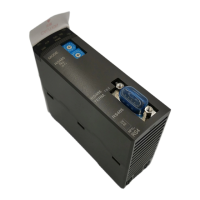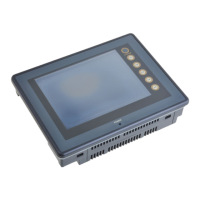1-44
Section 1 Specications
(2) Assigning variables to memory
When variables are declared and complied on the variables worksheet, they are assigned to the CPU internal memory. There
are two methods for assigning variables: the method that user species arbitrary address of the CPU internal memory (AT
specication) and the method that D300win allocates CPU internal memory during compilation.
<Rules for memory allocation>
For the variables to which no address is specied on the variables worksheet, D300win assigns addresses during compilation
according to the following rules:
• When user assigns variables to standard memory (high-speed), standard memory and retain memory, it is necessary to
specify addresses in the AT range.
• When no address is set in the “Address” column on the variables worksheet, D300win assigns addresses, from the top one in
order, that are out of the AT range of standard memory or retain memory.
<Example of assignment>
1) When user assigns a variable, such as variable “ERROR”, to standard memory, an address out of the AT range of standard
memory is specied.
2) When user species no address, like variables “Condition 1” and “Condition 2”, variables are assigned to the top one in order
of the addresses out of the AT range in the high-speed area of standard memory. If there is no longer an area to allocate in
the out-of-AT range of high-speed area, variables are assigned to the out-of-AT range of standard memory.
3) When user assigns a variable to retain memory (power-failure data retentive memory), like variable “Set_value_0”, an
address in the AT range of retain memory is specied.
4) If user species no address, like variables “Condition 3” and “RUN”, when the “RETAIN” box is checked, variables are
assigned to the top one in order of the addresses that are out of the AT range of retain memory.
Notes:
AT range is determined by default but can be changed by resource setting.
For details, see “3-3-2 CPU memory size denition.”
User species address to I/O memory.
User species address to
CPU internal memory.
D300win automatically allocates
CPU internal memory.
AT range
Standard
memory
Standard
memory
Retain
memory
AT range
AT range
Out of AT range
Out of AT range
Out of AT range
2)
3)
4)

